ALLIES KICK OFF WESTERN NEW GUINEA CAMPAIGN
Hollandia and Aitape, Northern New Guinea • April 21–22, 1944
The Pacific War in New Guinea, the second largest island in the world after neighboring Australia, lasted from January 1942 to several weeks past the surrender of Japan on August 14, 1945. Japanese invaders set first foot in the Australian-administered Mandated Territory of New Guinea, that is the northeastern quadrant of the island, on January 23, 1942, then invaded Northwestern New Guinea (the Dutch half of the island and a portion of adjacent northeastern New Guinea) beginning March 29/30, followed by a drawn-out attempt to overrun the southwestern quadrant of New Guinea, the Australian Territory of Papua, on July 21, 1942.
U.S. General Douglas MacArthur, since April 18, 1942, Supreme Commander of all Allied military forces in the Southwest Pacific Area, was determined to liberate the island of New Guinea as a stepping-stone to the reconquest of the American Commonwealth of the Philippines, which fell to the southward-driving Japanese juggernaut in May 1942. MacArthur’s rollback of Japanese conquests along the northwestern coast of New Guinea consisted of at least 10 major battles and subcampaigns, and started with near simultaneous amphibious landings in the Hollandia area early on this date, April 21, 1944, and the next morning at Aitape (see map below). The invaders met scant resistance due to most Japanese personnel fleeing the scene before the Americans’ arrival.
Dual landings near Hollandia (Operation Reckless, 30,000 men) and a landing at Aitape (Operation Persecution, 22,500 men) were intended to isolate the 20,000-man Japanese 18th Army garrison and its airbase, the largest in mainland New Guinea, at Wewak to the south. Led by Lt. Gen. Hatazō Adachi, his weary and starving soldiers had suffered severe losses at Lae and elsewhere on the jungle-covered, disease-ridden Huon Peninsula. Licking their wounds they withdrew northwest to their Wewak base. Unexpectedly they found themselves stymied from falling even further back to Hollandia by Allied landings there and at Aitape, 113 miles closer to Wewak. The Battle of Driniumor River was Adachi’s attempt to recapture Aitape and join forces with the 2nd Area Army in West Papua that was subordinated, like his, to the Japanese Southern Expeditionary Army Group headquartered in the Philippines.
The Battle of Driniumor River, aka Battle of Aitape (July 10 to August 25, 1944), was a slugfest in which Adachi and 10,000 men under his command came out the losers. On July 10–11 three Japanese regiments attacked and breached American lines on the Driniumor River, about 20 miles south of Aitape. The remainder of July saw heavy fighting on both riverbanks. Fighting devolved into hand-to-hand combat and skirmishes in the jungle until the enemy became a spent force. Adachi ordered a complete withdrawal toward Wewak on August 4. U.S. troops harassed Adachi’s rearguard. Assisting the Americans were U.S. and Australian aircraft and naval firepower. Battle casualties were roughly three times higher for the Japanese than the Americans’ 3,000, of which 440 were U.S. dead.
Following the Driniumor River drubbing, the Japanese 18th Army hunkered down in their few strongholds. Hunger, starvation, tropical diseases, and combat losses took their toll. In late 1944, as U.S. troops were released for service elsewhere in the Southwest Pacific Theater, leadership of the Western New Guinea Campaign passed to the Australians. Aussie “diggers” (soldiers) began clearing Adachi remnants from coastal areas starting around Aitape and advancing eastward to the Wewak area. On May 11, 1945, Adachi’s Wewak headquarters fell. Offensive operations continued in the backcountry until Adachi surrendered his sword and men to the Australian 6th Army Division in a ceremony near Wewak on September 13, 1945. This ceremony occurred 11 days after senior Japanese officials had engaged in a far grander ceremony stage-managed by Gen. MacArthur aboard the battleship USS Missouri anchored in Tokyo Bay.
Western New Guinea Campaign, April 21, 1944, to September 13, 1945
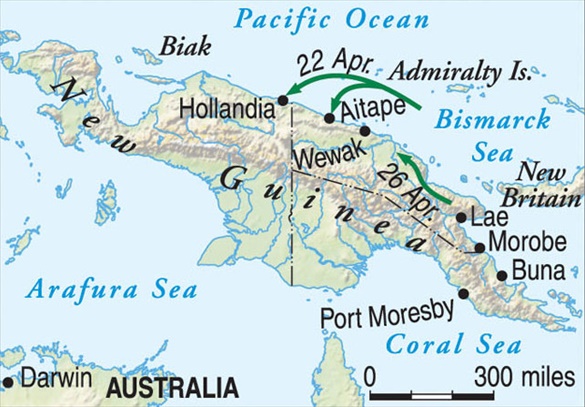 |
Above: During the colonial period the tropical island of New Guinea was divided longitudinally at the 141st meridian east between the Dutch in the west (today’s Indonesian province of West Papua), the Germans in the island’s northeast quadrant, and the British in the southeast quadrant. The German colony was converted by the League of Nations after World War I into a mandated territory administered by Australia. On April 21 and 22, 1944, the U.S. and Australia contested the Japanese conquest of the northern coast of New Guinea with near-simultaneous landings in the area of Hollandia (renamed Jayapura in 1968), then and now the administrative capital of West Papua, and Aitape in the Australian-mandated territory. Map source: Warfare History Network
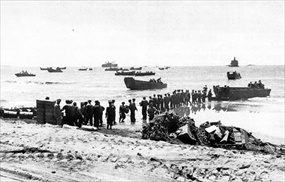 | 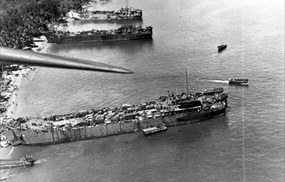 |
Left: U.S. soldiers unload supplies at Aitape, April 1944. Seizing Aitape and nearby airfields in what was part of the Australian-administered Territory of New Guinea helped secure the flank of U.S. forces fighting around Hollandia (Jayapura), Dutch New Guinea, 123 miles to the east. Two years before, the Japanese had occupied the Aitape region as part of their southward advance through the Southwest Pacific. Throughout 1943 and into 1944, U.S. and Australian forces began a series of offensives in New Guinea in concert with U.S. efforts to reduce and eventually neutralize the huge Japanese presence on the eastern tip of nearby New Britain Island (see map above), at Rabaul. The Western New Guinea Campaign, during the course of which the Allies slowly gained ascendency over the enemy, was part of a general U.S. advance northward toward the Philippines, the Japanese-occupied American commonwealth of islands, that was planned for 1944 and 1945.
![]()
Right: Aerial view of landing craft unloading U.S. troops and equipment on Beach Red Two, Tanahmerah Bay, April 21, 1944. In mid-April a flotilla of 217 U.S. aircraft carriers, escort vessels, and invasion forces heading for the north-central coast of New Guinea split into two parts: 22,500 infantrymen in Operation Persecution headed toward Aitape while roughly 30,000 men in Operation Reckless headed toward the Hollandia area. The latter contingent steamed into Humboldt Bay and a landing zone 2.5 miles from Hollandia as well as to Tanahmerah Bay 25 miles east of Hollandia in the early morning hours of April 21, 1944. The latter’s invasion beaches were so poor due to mud as to require many of the troops to debark at Humboldt Bay the next day, April 22. Hollandia was secured on April 23, 1944, when resistance by an enemy force of 11,000 men quickly collapsed. Japanese casualties approached 3,300 killed and 600 wounded. Allied casualties amounted to 157 dead and 1,057 wounded. Roughly 7,200 enemy troops attempted to escape death or capture, but only around 1,000 managed that feat. U.S. mopping up operations lasted into early June 1944 as the Allies made further landings west of Hollandia along the northern coast. In mid-July around 20,000 soldiers of the Japanese 18th Army launched their expected counterattack (enemy radio messages were read by MacArthur’s cryptanalysts), resulting in a staggering number of Japanese casualties 20 miles east of Aitape during the Battle of Driniumor River.
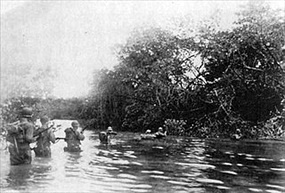 | 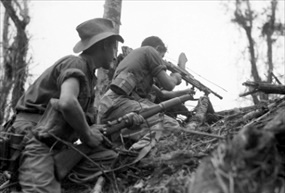 |
Left: U.S. infantrymen patrol along a river near Aitape during the Battle of Driniumor River, aka Battle of Aitape. The aim of Lt. Gen. Hatazō Adachi’s 18th Army was to bust through U.S. lines and recapture Aitape and its stocks of food and munitions. The April 1944 landings at Aitape and Hollandia (Jayapura) had isolated Adachi’s headquarters at Wewak from those of his superiors in the Philippines and from resupply. Between July 10 to August 25, 1944, Adachi’s original assault force of about 20,000 warriors was reduced by nearly half (8,000–10,000 wounded, missing, and dead from combat, starvation, or disease) in all-out attacks, skirmishes, and hand-to-hand fighting. After giving chase to the retreating foe, the Americans called the battle in their favor, despite Driniumor River being the second most-costly Allied campaign in the eastern half of the island after the Battle of Buna-Gona six months earlier (November 1942 to January 1943).
![]()
Right: An Australian light machine gun team takes aim at the enemy near Wewak, June 27, 1945. By the end of combat in September, most of Lt. Gen. Adachi’s Japanese 18th Army had been annihilated in the climactic episode of the Western New Guinea Campaign, the Australian-led Aitape-Wewak campaign (November 1944 to August 1945). From a 140,000-man force in 1943, barely 13,000 Japanese warriors were still alive when Adachi surrendered his exhausted army to the battle-hardened Australian 6th Division on September 13, 1945. Two years later Adachi, in Australian custody, took his life, having been charged by a military tribunal with war crimes in connection with mistreatment and arbitrary execution of Allied POWs.
Battle for New Guinea, 1942–1945: Australian and U.S. Soldiers in Action
![]()

 History buffs, there is good news! The Daily Chronicles of World War II is now available as an ebook for $4.99 on Amazon.com. Containing a year’s worth of dated entries from this website, the ebook brings the story of this tumultuous era to life in a compelling, authoritative, and succinct manner. Featuring inventive navigation aids, the ebook enables readers to instantly move forward or backward by month and date to different dated entries. Simple and elegant! Click
History buffs, there is good news! The Daily Chronicles of World War II is now available as an ebook for $4.99 on Amazon.com. Containing a year’s worth of dated entries from this website, the ebook brings the story of this tumultuous era to life in a compelling, authoritative, and succinct manner. Featuring inventive navigation aids, the ebook enables readers to instantly move forward or backward by month and date to different dated entries. Simple and elegant! Click 











